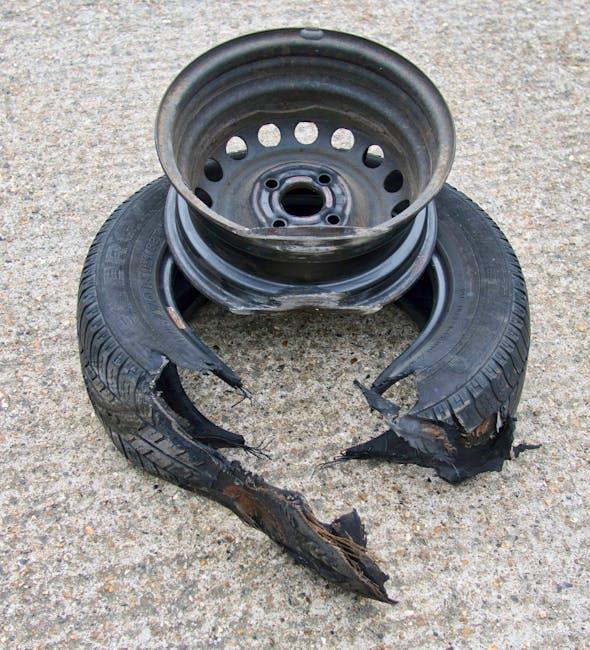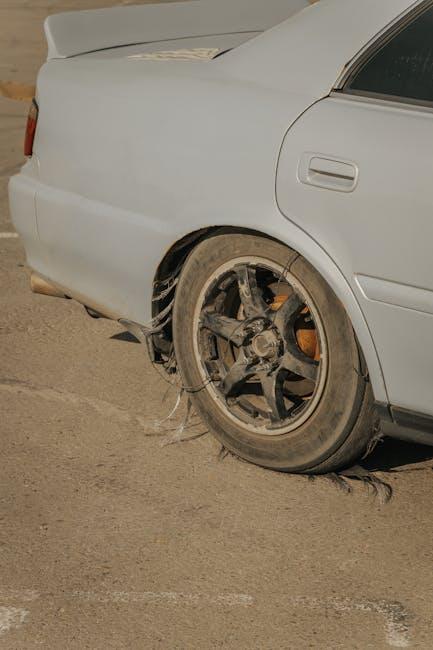There’s a certain kind of frustration that sneaks up when you discover your bike or car has a flat tire—right when you need to be on the move. But before calling for roadside help or heading to the shop, imagine having the confidence to fix it yourself, quickly and efficiently, without leaving your driveway. Patching a flat tire at home is a skill that blends practicality with a touch of DIY spirit, empowering you to turn an unexpected setback into a manageable task. In this guide, we’ll walk you through the straightforward steps to patch a flat tire, equipping you with the know-how to get rolling again in no time.
Table of Contents
- Gathering Essential Tools and Materials for Tire Repair
- Preparing Your Vehicle and Removing the Damaged Tire
- Identifying the Puncture and Assessing the Damage
- Step-by-Step Guide to Applying a Tire Patch Effectively
- Reinstalling the Tire and Performing a Safety Check
- Tips for Maintaining Your Tires and Preventing Future Flats
- Q&A
- In Conclusion

Gathering Essential Tools and Materials for Tire Repair
Before diving into the tire patching process, it’s crucial to assemble all the necessary tools and materials to ensure a smooth repair. At the very least, you’ll need a reliable tire patch kit which typically includes rubber patches, vulcanizing fluid, and sandpaper for surface preparation. Don’t forget essential tools such as a tire lever for removing the tire from the rim, a tire pressure gauge to check inflation, and a sturdy jack to lift your vehicle safely. Having these items readily available will save you time and frustration during the repair.
To help you organize, here’s a quick checklist of essentials:
- Tire patch kit: patches, glue, and sandpaper
- Tire lever: for removing tire from rim
- Tire pressure gauge: to ensure proper inflation
- Jack and lug wrench: to lift the car and remove wheel
- Bucket of water with soap: to locate leaks via bubbles
- Rag or cloth: for cleaning the tire surface
| Tool | Purpose |
|---|---|
| Tire Lever | Remove tire from rim |
| Patch Kit | Seal punctures |
| Pressure Gauge | Check tire pressure |
| Soap Water | Locate leaks |

Preparing Your Vehicle and Removing the Damaged Tire
Before you dive into repairing that flat, safety and preparation are paramount. Start by parking your vehicle on a flat, stable surface away from traffic, ideally on a driveway or a quiet street. Apply the parking brake and place wheel chocks or heavy objects behind the tires opposite to the damaged one to prevent any rolling. Gather your essential tools: a jack, lug wrench, gloves, and of course, the tire patch kit. Wearing bright clothing or a safety vest can also help increase visibility if you’re near a road.
With your vehicle secured, it’s time to remove the injured tire carefully. Loosen the lug nuts slightly while the tire is still on the ground to reduce strain when it’s lifted. Next, use the jack to raise the vehicle until the tire is off the ground, making sure the jack is positioned under the designated lift points in your car’s manual. Once elevated, remove the lug nuts fully and keep them in a safe place. Gently pull the tire off the wheel hub and set it aside—your flat tire is now ready for inspection and patching.

Identifying the Puncture and Assessing the Damage
Start by carefully examining the tire’s surface to locate the source of the leak. Common signs include small puncture holes, embedded nails, screws, or shards of glass that may be visibly lodged in the rubber. Run your fingers along the tread and sidewall as you look for any rough textures or foreign objects. To confirm the spot, you can also inflate the tire slightly and submerge sections in water, watching for bubbles that indicate escaping air. This hands-on approach ensures you pinpoint the damage accurately without guesswork.
Once the puncture is found, assess the severity and position of the damage. Not all punctures are created equal; a tiny nail hole in the tread area is generally repairable, but a deep cut on the sidewall or a large tear might mean the tire needs replacement. Use the quick reference below to determine if patching is a viable option:
| Damage Location | Repair Feasibility | Recommended Action |
|---|---|---|
| Tread Center | High | Patch or plug |
| Tread Shoulder | Moderate | Consult professional |
| Sidewall | Low | Replace tire |
| Large Cuts & Tears | None | Replace tire |

Step-by-Step Guide to Applying a Tire Patch Effectively
Begin by thoroughly cleaning the area around the puncture, removing dirt and debris to ensure a strong bond. Next, use sandpaper or a metal rasp to roughen the surface slightly; this helps the adhesive stick better. Apply a thin, even layer of rubber cement over the prepared spot and wait for it to become tacky—this usually takes a couple of minutes. Carefully peel the backing off the patch, then press it firmly onto the punctured area, making sure there are no air bubbles or wrinkles. Using a roller or the back of a spoon, smooth out the edges to create an airtight seal.
To guarantee longevity and effectiveness, allow the patch to cure fully before reinflating the tire. During this time, avoid any pressure or bending to prevent the patch from loosening. If you want a quick reference, consult the table below outlining the essential steps and approximate times involved:
| Step | Action | Estimated Time |
|---|---|---|
| 1 | Clean and roughen area | 3-5 minutes |
| 2 | Apply rubber cement | 1-2 minutes |
| 3 | Press patch firmly | 1 minute |
| 4 | Let cure | 10-15 minutes |
- Tip: Always work in a well-ventilated area when using adhesives.
- Reminder: Inspect patches regularly to ensure they remain secure.

Reinstalling the Tire and Performing a Safety Check
Once your patch is securely in place, it’s time to carefully remount the tire on the rim. Start by aligning the tire bead with the rim edge and gently push the tire back into position. Use tire levers if needed, but avoid excessive force to prevent damage. Inflate the tire slowly, checking to ensure the bead seats evenly around the rim. This crucial step helps avoid leaks and ensures the tire is perfectly balanced for a smooth ride.
Performing a thorough safety check will guarantee your patched tire is ready for the road. Verify the tire pressure against the manufacturer’s recommended PSI, inspect the patch for any signs of lifting or air seepage, and spin the wheel to confirm it rotates freely without wobbling. Here’s a quick checklist to streamline your safety routine:
- Measure tire pressure using a reliable gauge.
- Inspect the patch for firm adhesion and no gaps.
- Check tire seating all around the rim.
- Spin the wheel to detect any unusual vibrations.
- Test brake alignment if applicable.

Tips for Maintaining Your Tires and Preventing Future Flats
Proper tire maintenance goes beyond just fixing a flat; it’s about preventing one from happening in the first place. Start by regularly inspecting your tires for signs of wear, embedded debris, or uneven tread patterns. Make it a habit to check your tire pressure monthly—underinflated tires generate excess heat and increase the likelihood of punctures, while overinflated tires can wear unevenly and reduce traction. Consider rotating your tires every 5,000 to 7,000 miles to ensure balanced wear and maximize their lifespan.
Consistent care can keep your tires road-ready and extend the intervals between flats. Here are some practical habits to embed into your routine:
- Keep an eye out for cracks or bulges on the sidewalls, as these signal weakened tire structure.
- Avoid driving over potholes or sharp objects whenever possible, as sudden impacts can cause hidden damage.
- Use a quality tire sealant or get puncture-resistant tires if you frequently drive in rough conditions.
| Maintenance Task | Recommended Frequency |
|---|---|
| Check Tire Pressure | Monthly |
| Inspect for Debris/Damage | Before every trip |
| Tire Rotation | Every 5,000-7,000 miles |
Q&A
Q&A: How to Patch a Flat Tire at Home
Q1: What’s the first thing I should do when I discover a flat tire at home?
A1: Stay calm and move your vehicle to a safe, flat surface away from traffic. Engage the parking brake and gather your tools before beginning the repair.
Q2: What tools and materials do I need to patch a flat tire myself?
A2: You’ll need a tire repair kit (which usually includes a patch, glue, and roughening tool), a jack to lift the car, a lug wrench, and optionally a tire pressure gauge and air pump.
Q3: How do I safely remove the tire from the vehicle?
A3: Loosen the lug nuts while the tire is still on the ground, then use the jack to lift the vehicle. Once elevated, remove the lug nuts and tire completely.
Q4: How do I locate the puncture in the tire?
A4: Inflate the tire slightly and spray soapy water over its surface. Look for bubbles forming, which indicate air escaping from the puncture. Mark this spot for repair.
Q5: What’s the best way to prepare the tire for patching?
A5: Use the roughening tool to scuff around the puncture area inside the tire. This helps the patch adhere better. Clean the area thoroughly before applying any glue or patch.
Q6: How exactly do I apply the patch?
A6: Spread the adhesive around the puncture, let it become tacky, then firmly press the patch over the spot. Hold it in place for a few minutes to ensure a strong bond.
Q7: Can I patch any type of flat tire at home?
A7: While many small punctures can be repaired, large gashes or sidewall damage are unsafe to patch. In such cases, professional help or tire replacement is necessary.
Q8: How do I know if the patch worked?
A8: After the patch dries, reinflate the tire fully and check again with soapy water for leaks. Also, monitor the tire pressure over the next few days to ensure it holds steady.
Q9: How long does a home tire patch typically last?
A9: When done correctly, a patch can last the life of the tire. However, it’s wise to have the tire inspected by a professional to confirm it’s safe for long-term use.
Q10: Are there tips to prevent future flats or damage?
A10: Regularly check tire pressure, avoid driving over sharp objects, and ensure tires have adequate tread. Routine maintenance reduces the risk of flat tires and keeps you safer on the road.
In Conclusion
Patching a flat tire at home isn’t just a handy skill—it’s a small victory over the unexpected. With a bit of patience, the right materials, and careful attention, you can bring your tire back to life and keep your journey rolling smoothly. Next time the road throws a curveball, remember: a patch isn’t just a fix—it’s a reminder that sometimes, all it takes is a little effort to get moving again. Safe travels!

